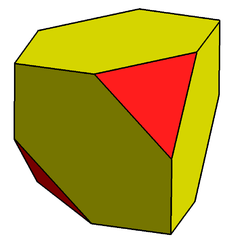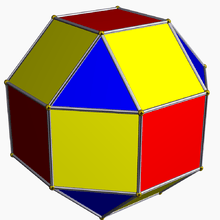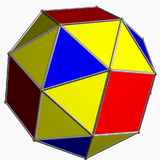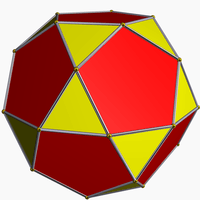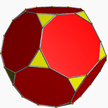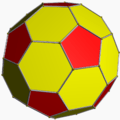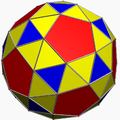Truncated cube
| Truncated cube | |
|---|---|
 (Click here for rotating model) | |
| Type | Archimedean solid Uniform polyhedron |
| Elements | F = 14, E = 36, V = 24 (χ = 2) |
| Faces by sides | 8{3}+6{8} |
| Conway notation | tC |
| Schläfli symbols | t{4,3} |
| t0,1{4,3} | |
| Wythoff symbol | 2 3 | 4 |
| Coxeter diagram | |
| Symmetry group | Oh, B3, [4,3], (*432), order 48 |
| Rotation group | O, [4,3]+, (432), order 24 |
| Dihedral Angle | 3-8: 125°15′51″ 8-8: 90° |
| References | U09, C21, W8 |
| Properties | Semiregular convex |
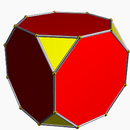 Colored faces |
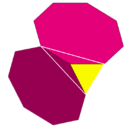 3.8.8 (Vertex figure) |
 Triakis octahedron (dual polyhedron) |
 Net |
In geometry, the truncated cube, or truncated hexahedron, is an Archimedean solid. It has 14 regular faces (6 octagonal and 8 triangular), 36 edges, and 24 vertices.
If the truncated cube has unit edge length, its dual triakis octahedron has edges of lengths 2 and 2 + √2.
Area and volume
The area A and the volume V of a truncated cube of edge length a are:
Orthogonal projections
The truncated cube has five special orthogonal projections, centered, on a vertex, on two types of edges, and two types of faces: triangles, and octagons. The last two correspond to the B2 and A2 Coxeter planes.
| Centered by | Vertex | Edge 3-8 |
Edge 8-8 |
Face Octagon |
Face Triangle |
|---|---|---|---|---|---|
| Truncated cube |
 |
 |
 |
 |
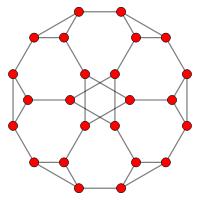 |
| Triakis octahedron |
 |
 |
 |
 |
 |
| Projective symmetry |
[2] | [2] | [2] | [4] | [6] |
Spherical tiling
The truncated cube can also be represented as a spherical tiling, and projected onto the plane via a stereographic projection. This projection is conformal, preserving angles but not areas or lengths. Straight lines on the sphere are projected as circular arcs on the plane.
 |
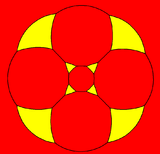 octagon-centered |
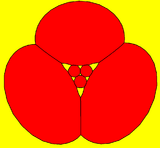 triangle-centered |
| Orthographic projection | Stereographic projections | |
|---|---|---|
Cartesian coordinates
The following Cartesian coordinates define the vertices of a truncated hexahedron centered at the origin with edge length 2ξ:
- (±ξ, ±1, ±1),
- (±1, ±ξ, ±1),
- (±1, ±1, ±ξ)
where ξ = √2 − 1.
The parameter ξ can be varied between ±1. A value of 1 produces a cube, 0 produces a cuboctahedron, and negative values produces self-intersecting octagrammic faces.
If the self-intersected portions of the octagrams are removed, leaving squares, and truncating the triangles into hexagons, truncated octahedrons are produced, and the sequence ends with the central squares being reduced to a point, and creating an octahedron.
Dissection

The truncated cube can be dissected into a central cube, with six square cupola around each of the cube's faces, and 8 regular tetrahedral in the corners. This dissection can also be seen within the runcic cubic honeycomb, with cube, tetrahedron, and rhombicuboctahedron cells.
This dissection can be used to create a Stewart toroid with all regular faces by removing two square cupola and the central cube. This excavated cube has 16 triangles, 12 squares, and 4 octagons.[1][2]
Vertex arrangement
It shares the vertex arrangement with three nonconvex uniform polyhedra:
 Truncated cube |
 Nonconvex great rhombicuboctahedron |
 Great cubicuboctahedron |
 Great rhombihexahedron |
Related polyhedra
The truncated cube is related to other polyhedra and tlings in symmetry.
The truncated cube is one of a family of uniform polyhedra related to the cube and regular octahedron.
| Uniform octahedral polyhedra | ||||||||||
|---|---|---|---|---|---|---|---|---|---|---|
| Symmetry: [4,3], (*432) | [4,3]+ (432) |
[1+,4,3] = [3,3] (*332) |
[3+,4] (3*2) | |||||||
| {4,3} | t{4,3} | r{4,3} r{31,1} |
t{3,4} t{31,1} |
{3,4} {31,1} |
rr{4,3} s2{3,4} |
tr{4,3} | sr{4,3} | h{4,3} {3,3} |
h2{4,3} t{3,3} |
s{3,4} s{31,1} |
= |
= |
= |
||||||||
| Duals to uniform polyhedra | ||||||||||
| V43 | V3.82 | V(3.4)2 | V4.62 | V34 | V3.43 | V4.6.8 | V34.4 | V33 | V3.62 | V35 |
Symmetry mutations
This polyhedron is topologically related as a part of sequence of uniform truncated polyhedra with vertex configurations (3.2n.2n), and [n,3] Coxeter group symmetry, and a series of polyhedra and tilings n.8.8.
| *n32 symmetry mutation of truncated spherical tilings: t{n,3} | |||||||||||
|---|---|---|---|---|---|---|---|---|---|---|---|
| Symmetry *n32 [n,3] |
Spherical | Euclid. | Compact hyperb. | Paraco. | |||||||
| *232 [2,3] |
*332 [3,3] |
*432 [4,3] |
*532 [5,3] |
*632 [6,3] |
*732 [7,3] |
*832 [8,3]... |
*∞32 [∞,3] | ||||
| Truncated figures |
|
 |
 |
 |
 |
 |
 |
 | |||
| Symbol | t{2,3} | t{3,3} | t{4,3} | t{5,3} | t{6,3} | t{7,3} | t{8,3} | t{∞,3} | |||
| Triakis figures |
 |
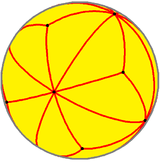 |
 |
 |
 |
 | |||||
| Config. | V3.4.4 | V3.6.6 | V3.8.8 | V3.10.10 | V3.12.12 | V3.14.14 | V3.16.16 | V3.∞.∞ | |||
| *n42 symmetry mutation of truncated tilings: n.8.8 | |||||||||||
|---|---|---|---|---|---|---|---|---|---|---|---|
| Symmetry *n42 [n,4] |
Spherical | Euclidean | Compact hyperbolic | Paracompact | |||||||
| *242 [2,4] |
*342 [3,4] |
*442 [4,4] |
*542 [5,4] |
*642 [6,4] |
*742 [7,4] |
*842 [8,4]... |
*∞42 [∞,4] | ||||
| Truncated figures |
 |
 |
 |
 |
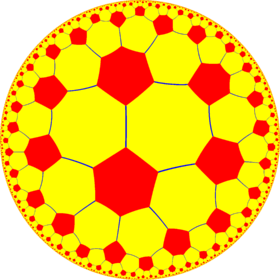 |
 |
 |
 | |||
| Config. | 2.8.8 | 3.8.8 | 4.8.8 | 5.8.8 | 6.8.8 | 7.8.8 | 8.8.8 | ∞.8.8 | |||
| n-kis figures |
 |
 |
 |
 |
 |
 |
 |
 | |||
| Config. | V2.8.8 | V3.8.8 | V4.8.8 | V5.8.8 | V6.8.8 | V7.8.8 | V8.8.8 | V∞.8.8 | |||
Alternated truncation
A cube can be alternately truncated producing tetrahedral symmetry, with six hexagonal faces, and four triangles at the truncated vertices. It is one of a sequence of alternate truncations of polyhedra and tiling.
Related polytopes
The truncated cube, is second in a sequence of truncated hypercubes:
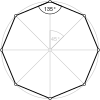 |
  |
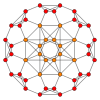 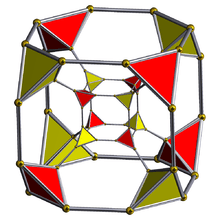 |
 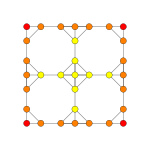 |
 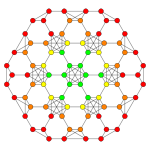 |
  |
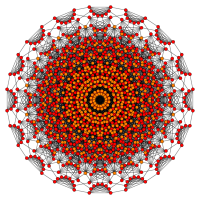  |
... |
| Octagon | Truncated cube | Truncated tesseract | Truncated 5-cube | Truncated 6-cube | Truncated 7-cube | Truncated 8-cube | |
Truncated cubical graph
| Truncated cubical graph | |
|---|---|
|
4-fold symmetry schlegel diagram | |
| Vertices | 24 |
| Edges | 36 |
| Automorphisms | 48 |
| Chromatic number | 3 |
| Properties | Cubic, Hamiltonian, regular, zero-symmetric |
In the mathematical field of graph theory, a truncated cubical graph is the graph of vertices and edges of the truncated cube, one of the Archimedean solids. It has 24 vertices and 36 edges, and is a cubic Archimedean graph.[3]
 Orthographic |
See also
- Spinning truncated cube
- Cube-connected cycles, a family of graphs that includes the skeleton of the truncated cube
References
- ↑ B. M. Stewart, Adventures Among the Toroids (1970) ISBN 978-0-686-11936-4
- ↑ http://www.doskey.com/polyhedra/Stewart05.html
- ↑ Read, R. C.; Wilson, R. J. (1998), An Atlas of Graphs, Oxford University Press, p. 269
- Williams, Robert (1979). The Geometrical Foundation of Natural Structure: A Source Book of Design. Dover Publications, Inc. ISBN 0-486-23729-X. (Section 3-9)
- Cromwell, P. Polyhedra, CUP hbk (1997), pbk. (1999). Ch.2 p.79-86 Archimedean solids
External links
- Klitzing, Richard. "3D convex uniform polyhedra o3x4x - tic".
- Editable printable net of a truncated cube with interactive 3D view
- The Uniform Polyhedra
- Virtual Reality Polyhedra www.georgehart.com: The Encyclopedia of Polyhedra
- VRML model
- Conway Notation for Polyhedra Try: "tC"


